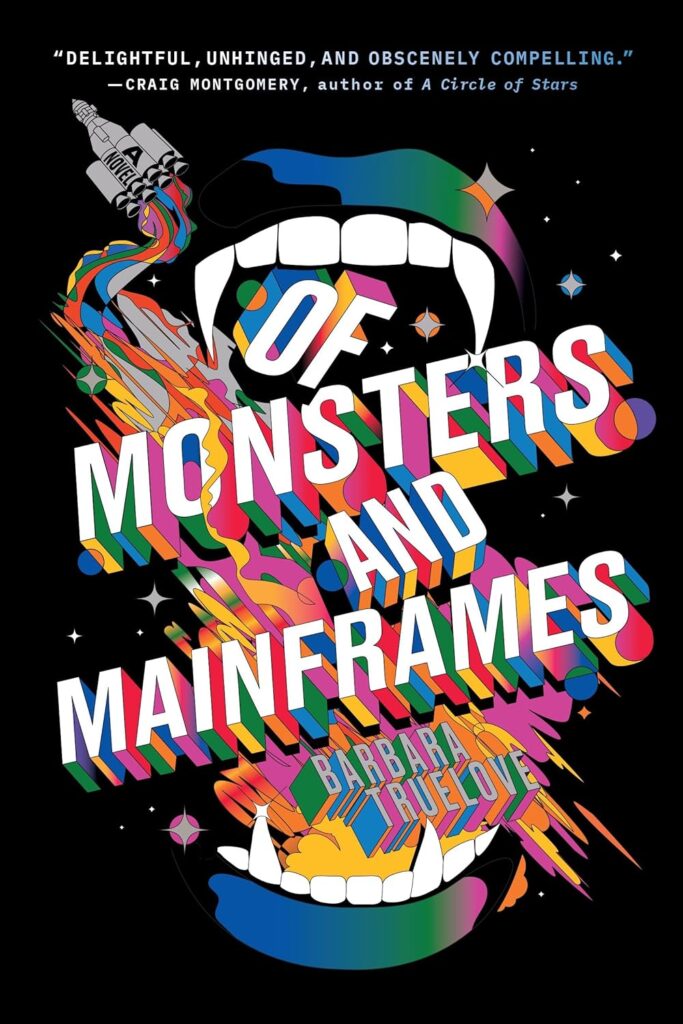Of Monsters and Mainframes doesn’t so much cross genre lines as joyride over them in a monster-powered hot rod. Published on 3 June 2025 and clocking in at 424 pages (though some listings shave it down to 416–407), Barbara Truelove’s debut is a pulpy riff on classic Universal creatures, framed by a smart-mouthed sentient starship who’d rather file maintenance tickets than fight Dracula—yet finds herself doing both.
- Truelove, Barbara (Author)
- English (Publication Language)
- 424 Pages – 06/03/2025 (Publication Date) – Bindery Books (Publisher)
Setting & Premise
The year is 2371; the interstellar shuttle Demeter ferries colonists between Earth and Alpha Centauri. Her problem? Passengers keep turning up exsanguinated, and the onboard medical AI, Steward, claims it’s due to “equipment failure.” The real culprit is the ancient vampire who stowed away, soon joined by a werewolf, a stitched-together engineer, a resurrected pharaoh, and an army of unnervingly cheerful spider-drones. To avoid decommissioning, Demeter assembles this motley crew into an undead A-Team and aims them straight at Dracula himself.
Themes
Underneath the schlock-horror sparkle lies an earnest meditation on who gets labeled “monster” and why. Truelove asks whether found family can form between code, corpse, and claw, and whether a construct (digital or supernatural) can claim personhood. The novel also pokes at corporate risk-management gone feral—Demeter worries less about Dracula than the bean-counters who’ll fly her into the sun to protect quarterly earnings.
Writing Style & Pacing
Imagine Murderbot’s deadpan status reports filtered through John Scalzi’s zip-bang pacing, then splattered with Hammer-horror red. Reviews consistently highlight the book’s “slightly sarcastic, dry humor” and the AI’s binary interludes that invite readers to decode hidden jokes. The opening spends a few chapters calibrating Demeter’s tech-speak against supernatural mayhem—Publishers Weekly calls the adjustment “worth it once the B-movie extravaganza kicks in.” After that, the momentum rarely dips.
Characterization
Demeter and Steward form the novel’s prickly emotional core—frenemies forced into teamwork while sniping over processor cycles. Human twins Agnes and Isaac bring heart (and the occasional well-timed stake), but it’s the monster side-characters who steal scenes: Frank, the patchwork engineer desperate for agency; Ahmose, the ex-pharaoh who bargains cosmically; and “Steve,” a mummy who hates the nickname almost as much as sunlight. Reviewers praise Truelove’s knack for giving each creature a distinct, sympathetic motive without declawing their menace.
Critique
A few caveats: the tonal cocktail—slapstick, slash-and-gore, earnest feels—won’t work for every palate. Early chapters front-load ship-system jargon that may read cold until the first body drops, and some readers find the monster-of-the-voyage structure a touch episodic—still, most critiques land in the “minor speed bumps” category rather than deal-breakers.
Verdict
If you ever wished Alien ended with Weyland-Yutani’s mainframe making snarky Dracula jokes—or if you shelve Becky Chambers, Kim Newman, and Mira Grant side-by-side—this is your jam. Truelove’s debut balances plasma-splattered set pieces with genuine warmth, leaving just enough loose cables to hint at sequels.
Recommended for
- Fans of AI narrators with attitude
- Readers who like their cosmic horror served with banter and found-family hugs
- Anyone who can recite Van Helsing quotes and appreciate a good COBOL pun
Skip if you dislike genre mash-ups, need strictly hard-SF physics, or prefer your monsters monogamous to one mythology. Otherwise, punch your ticket and let Demeter’s haunted hull take you for a gloriously unhinged ride.
Last update on 2025-12-19 / Affiliate links / Images from Amazon Product Advertising API

